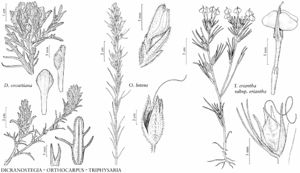Dicranostegia
Proc. Acad. Nat. Sci. Philadelphia 99: 189. 1947.
| Taxon | Illustrator ⠉ | |
|---|---|---|
 | Dicranostegia orcuttiana Orthocarpus luteus Triphysaria eriantha subsp. eriantha | John Myers Barbara Alongi Barbara Alongi |
Herbs, annual; hemiparasitic. Stems erect or ascending, rarely prostrate, not fleshy, pubescent, hirsute, or glabrous. Leaves cauline, alternate; petiole absent; blade not fleshy, not leathery, margins pinnately 8–11-lobed. Inflorescences terminal, spikes; bracts present. Pedicels absent; bracteoles absent. Flowers: sepals 2, calyx bilaterally symmetric, spathelike, lobes triangular; petals 5, corolla white to yellow, marked with purple, strongly bilabiate, club-shaped, often gibbous at base of lobes, abaxial lobes 3, adaxial lobes 2, adaxial lip galeate; stamens 2, filaments glabrous or proximally pubescent, pollen-sacs separate, connective elongate; staminodes 2, filiform; ovary 2-locular, placentation axile; stigma not expanded. Capsules: dehiscence loculicidal. Seeds 5–20, brown, ovoid, wings absent. x = 8.
Distribution
Calif., nw Mexico
Discussion
Species 1.
Dicranostegia is sometimes classified as Cordylanthus subg. Dicranostegia (A. Gray) T. I. Chuang & Heckard. D. C. Tank et al. (2009) have shown that Dicranostegia is closely related to Chloropyron and that both genera form a clade that is sister to Castilleja and Triphysaria.
Like Chloropyron and Cordylanthus, Dicranostegia has closed, club-shaped flowers with a spathelike calyx. Flowers are subtended by a single, elongate bracteole and pinnate bracts. Dicranostegia differs in having pinnately lobed leaves, deeply two-parted calyces that are about half as long as the corollas, and stamens with pollen sacs held apart on relatively short connectives.